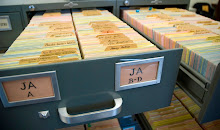
Record Content: Dates
<date> The date element is the most important piece of information on each slip. The physical card file, as well as the physical archive collection and the microfilm, is arranged chronologically. It is the first access point to the documents. It is also the most complicated, due to the variety of date formats and the rules regarding sorting. The date section of the full schema is derived from the unique dating structure of the control file, as it was originally organized and inventoried. As noted above, all text in the date field is retained as is and the attributes control the data for sorting and searching.
Required Attributes
The <date> requires a choice of one of the following attributes:
@when.
The most comment type of date found in the control file are exact dates with a known day, month, and year. These are controlled in the @when with a date parameter of year-month-day (YYYY-MM-DD). If either the month or day is uncertain, encode the @when with "99", i.e. YYYY-99-99. This will allow for proper sorting—complete dates come before incomplete dates.
Example: <date when="1771-12-21">21 Dec. 1771.</date>
<date when="1776-07-99">July 1776</date>
@when and @ante.
Any date that is known to be written before a certain date using the term "ante." These are also controlled with the standard date parameter year-month-day.
Example: <date when="1790-07-11" ante="ante">ante 11 July 1790</date>
@when and @post.
Any date that is known to be written after a certain date using the term "post."
Example: <date when="1790-07-11" post="post">post 11 July 1790</date>
@when and @to.
Any range of dates with a known beginning and end. These elements must be used as a group.
Example: <date when="1790-07-11" to="1790-08-31">11 July–31 Aug. 1790</date>
Optional Attributes
The following attributes may be added to any of the required attributes above:
@circa.
Any of the above four types of dates (when, when/ante, when/post, and when/to) that are preceded by a "ca." or "circa" should also include the @circa. The value is "yes" and @circa can be combined with any other date attributes.
Example: <date when="1745-10-21" circa="yes">ca. 21 Oct. 1745</date>
@conjectural.
Any date that appears in brackets is a conjectural date. The date may be conjectural for a variety of reasons (illegible, not present on the letter, supplied by context), but the key feature is the use of brackets. The value is "yes" and @conjectural may be combined with any other date attributes.
Example: <date when="1772-12-02" conjectural="yes">2 Dec. [1772]</date>
@noDate.
Any date field that includes the phrase "n.d." should have the @noDate. This may appear alone, but more often accompanies a supplied date in brackets. The @noDate may be combined with any other date attribute.
Example: <date noDate="yes" post="1773-06-16" conjectural="yes" >n.d. [post 16 June 1773?]</date>
@rank.
The rank will be added using a separate XSL transformation. The ranking will be determined based on the number of attributes to allow for proper sorting.
A note on sorting.
The sorting rules for the database will follow the filing rules used in the physical paper file. Not only are the editors already familiar with these rules, they are the most logical method for the variety of dates—certain and uncertain, complete and incomplete—found in the control file. The original directive adequately described the sorting:
The file contains all ribbon copies of all four types of control slips. In cases where several slips represent different versions of the same document, the order of filing is as follows:
Pink (CDF), White (Letterbook), Yellow (Accession), Blue (Printed or Manuscript Lead)
Arrangement of slips in this file follows strict chronological order throughout the entire span of our documents, 1639-1889. Dates which contain all three elements (day, month, and year) precede those which are incomplete. Inclusive dates are filed under the earlier of the dates, but following all other slips for that day. (An exception to this rule is the filing of accounts with inclusive dates, which go under the later of the inclusive dates, but preceding all other slips for that day.) An example may be taken from the end of a theoretical year:
Ante 15 Dec. 1800
15 Dec. 1800
15-19 Dec. 1800
31 Dec. 1800
31 Dec. 1800-21 Jan. 1801
31 Dec. 1800-18 May 1801
Dec. 1800
1800
Ca. 1800
[1800?]
1800-1809
[post 1800]


